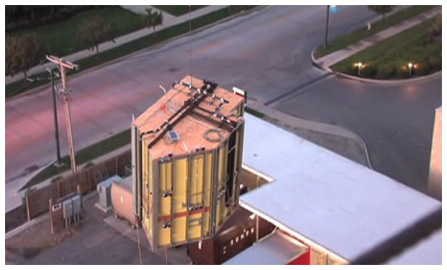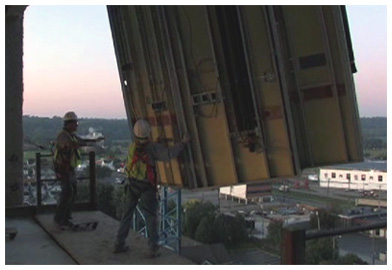 The current ongoing cardiac expansion to the Miami Valley Hospital in Dayton, Ohio is nearing completion, and marks a great success for the emerging field of prefabricated corporate construction. “Prefab” construction is nothing new. L. Manning built houses in London that were assembled in Australia during the early 1800’s, and during the 20th century, many houses were built in factories to replace those bombed in London during World War II. But never before has it been implemented on this scale, with such overwhelmingly superior results: every one of the 178 patient rooms of the 12-story, 440,000 square foot project was built off-site, and was built more quickly, inexpensively and safely than could have been accomplished through traditional methods.
The current ongoing cardiac expansion to the Miami Valley Hospital in Dayton, Ohio is nearing completion, and marks a great success for the emerging field of prefabricated corporate construction. “Prefab” construction is nothing new. L. Manning built houses in London that were assembled in Australia during the early 1800’s, and during the 20th century, many houses were built in factories to replace those bombed in London during World War II. But never before has it been implemented on this scale, with such overwhelmingly superior results: every one of the 178 patient rooms of the 12-story, 440,000 square foot project was built off-site, and was built more quickly, inexpensively and safely than could have been accomplished through traditional methods. Just how is it that doing the labor-intensive work off-site can make such a huge difference? Well, by building the patient rooms and overhead utility racks in a warehouse, workers can freely move from one unit to the next without obstructing each other, without carrying equipment up and down ladders and stairwells, without anyone having to worry about getting concrete dust in their eyes, and without having to do any hammering or welding over their own heads. The climate-controlled conditions of the warehouse where the units are built allow for more efficient, comfortable work at all times of the year. And because the building components are well organized in a place, workers spend much less time looking for the pieces of the building that they are assembling – only 15-20 minutes per worker per day, compared to the 90 plus minutes typical for on-site construction of larger projects. The hospital expansion is now 90% complete, and the current projection is to finish more than two months ahead of schedule and 2% under budget. Prefab building is also greener. With projects being built in one location, leftover materials can be collected and used on other projects rather than winding up in a waste dumpster at the building site.
Just how is it that doing the labor-intensive work off-site can make such a huge difference? Well, by building the patient rooms and overhead utility racks in a warehouse, workers can freely move from one unit to the next without obstructing each other, without carrying equipment up and down ladders and stairwells, without anyone having to worry about getting concrete dust in their eyes, and without having to do any hammering or welding over their own heads. The climate-controlled conditions of the warehouse where the units are built allow for more efficient, comfortable work at all times of the year. And because the building components are well organized in a place, workers spend much less time looking for the pieces of the building that they are assembling – only 15-20 minutes per worker per day, compared to the 90 plus minutes typical for on-site construction of larger projects. The hospital expansion is now 90% complete, and the current projection is to finish more than two months ahead of schedule and 2% under budget. Prefab building is also greener. With projects being built in one location, leftover materials can be collected and used on other projects rather than winding up in a waste dumpster at the building site. Although the results in the Miami Valley Heart Center clearly speak for themselves, the process comes with a few specific considerations. First and foremost, the decision to use a prefab approach to a project must be made very early – once on-site construction has begun, you lose many of the benefits of the prefabricated alternative. Additionally, all elements of planning and design must be taken care of before workers can begin assembling the first units. And finally, there is the consideration that a large-scale industry shift away from traditional construction, while beneficial to contractors and their clients, will undoubtedly cost many more construction workers their jobs: a prefabricated approach requires substantially less manpower to complete the same amount of work.
Although the results in the Miami Valley Heart Center clearly speak for themselves, the process comes with a few specific considerations. First and foremost, the decision to use a prefab approach to a project must be made very early – once on-site construction has begun, you lose many of the benefits of the prefabricated alternative. Additionally, all elements of planning and design must be taken care of before workers can begin assembling the first units. And finally, there is the consideration that a large-scale industry shift away from traditional construction, while beneficial to contractors and their clients, will undoubtedly cost many more construction workers their jobs: a prefabricated approach requires substantially less manpower to complete the same amount of work.
Some developers may adopt this approach as a solution for the shortage of skilled craftspersons which they will face once construction picks up speed again. Certainly this is an example of another reason for workers to invest in themselves through training and certification programs which will allow them to participate in the future of the industry.
For more information, watch this excellent video from McGraw Hill Construction’s Video Library.
Note: The original video is no longer available, but I found the following 6½ minute video by Skanska USA, the general contractor on this project. - EM
Prefab Construction: Not Just For Trailer Parks Anymore [VIDEO]
by Elizabeth McPherson | September 24, 2010



Comments
Prefab Caused Outbreak?
Please note that there is now questions about Prefab's role in an Infectious disease outbreak at this hospital: http://www.daytondailynews.com/news/news/local/bacteria-problem-reported-at-hospital-at-least-4-p/nMpSD/
Add new comment